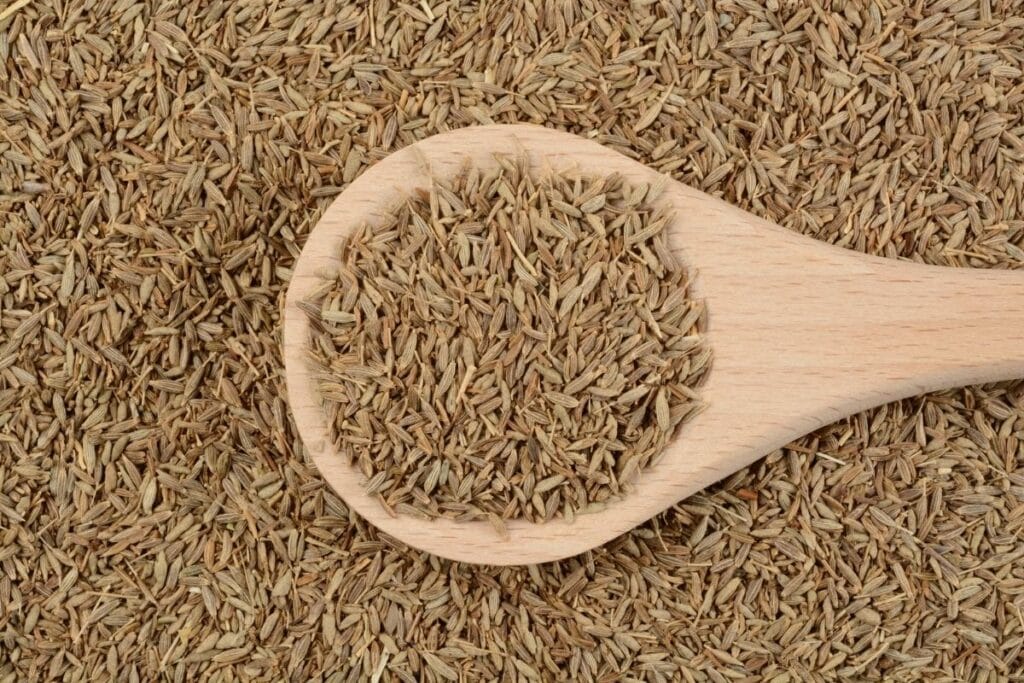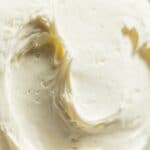In a nutshell: Coriander, caraway seeds, paprika, fennel seeds, fenugreek seeds, etc. are all good substitutes for cumin. Each substitute offers different flavors and heat levels, suitable for various cuisines.
If you’re using meat rubs, premixed seasonings, Indian spice blends, pickling spices, or Tex-Mex, you are probably using more cumin than you realize. Cumin is used in cuisines globally from traditional French bread, Leyden cheese, curry, and barbecue to Mexican and African sauces, soups, and stews.
If you’re firing up the barbecue or mixing your curry spices and realize there’s no cumin in the pantry, there are replacements you can use to give your dish the same aromatic quality. Depending on the type of cuisine you generally cook, you will probably have at least one of the below recommended cumin substitutes at home already.
Before we get to the best substitute for cumin powder and seeds, let’s look at what exactly cumin is.
What is Cumin?
Cumin, parsley, coriander, and caraway are all part of the same herb family. Dried cumin and caraway are often confused, but they are completely different spices. Cumin’s warm flavor adds complexity to dishes. It is commonly available in a yellow-brown color seed, lighter than that of caraway. Less common varieties are also found in green, white, or black.
The seeds are hotter to taste and bigger in size than caraway seeds. They can be used whole, crushed, or finely ground into a powder.
To intensify the flavor of cumin, the whole seeds should be dry roasted over low heat just until toasty and then crushed or ground using a mortar and pestle or spice grinder.
Best Cumin Substitutes
The best ground cumin substitute to use as a replacement may vary according to what you are cooking.
Coriander
Coriander and cumin are both relatives of the parsley family which makes coriander seeds a suitable and versatile replacement. They both have a rich color and earthy flavor, however, coriander lacks the same amount of spiciness.
Use equal amounts of toasted seeds or finely ground coriander as required and add a little cayenne pepper or red chili flakes for more heat. Coriander has underlying lemony notes, so consider this in the dish you are cooking as it may not pair well with Tex-Mex type dishes. It is, however, a good swap in Middle-Eastern dishes, Indian, and Asian curries.
See more: Coriander replacement
Caraway Seeds
Caraway seeds are often included in Indian or Middle-Eastern spice mixes, rye bread, and potato salad. When it comes to appearance, caraway and cumin seeds are very similar. Their warm and earthy taste makes them a great replacement; however, caraway does have a slight anise flavor and less heat.
Like with coriander seeds, adding a little cayenne or chili can give you added spiciness. If you are purposefully looking for something slightly milder, this is a good choice.
Replace ground caraway for cumin powder and opt for seeds to replace whole cumin seeds in your recipe. The spice is ideal for use in dips, Indian, Middle-Eastern, and salad recipes.
Related: Caraway seeds substitute
Paprika
This is an option you most likely already have in the pantry. Paprika is a good alternative for ground cumin, although the color of your dish may have a red tinge rather than brown. It will add warmth, spice, and complexity but will lack any citrus undertones. If you are missing this in your dish add a little lemon zest while cooking.
Paprika is known for its smokiness which beautifully rounds out flavors in marinades, dry rubs, stews, and curries. It can also be successfully incorporated in dressings and dips.
Fennel Seeds
Whole fennel seeds can offer texture to salads and make a suitable substitute for whole seeds. They are best used in meat rubs, stews, curries, dressings, bread, pickles, and salads such as potato salad.
Although they belong to the same herb family as cumin and parsley, they have a different undertone with a prominent anise and licorice flavor. They don’t have any heat so if that’s essential to your dish add a little crushed pepper.
If you want to boost the flavor or grind the seeds first toast them in a dry pan just until they turn a light brown color and smell aromatic.
Keep in mind when using fennel seeds that the flavor won’t necessarily match that of cumin and that your dish will taste a little different than intended. Stick to Indian, Middle-Eastern, and African dishes to make sure the flavor profiles remain compatible.
See more: substitute for fennel
Fenugreek Seeds
Fenugreek has been praised for its nutritional benefits so if there’s a reason to try it as a substitute then lowering cholesterol, aiding digestive wellbeing, improving hair and scalp health are all on the list.
It has a much sweeter and less spicy taste compared to cumin. Its bitter taste is not prominent once heated during cooking, leaving only the sweet, nutty, and light mustardy tones which are delicious with roasted vegetables and add rich fragrant notes in curry. The yellow seeds can do with some addition of cayenne pepper or paprika to boost the lacking level of heat.
Fenugreek seeds are best used in their whole form. Use only half the amount required in the recipe when replacing cumin and then add more to taste if necessary. If you want to grind the seeds into a powder for use in marinades and dressings, dry roast them before grinding to make sure they are not bitter. Fenugreek seeds pair best with Middle-Eastern cuisines and Indian dishes.
See more: fenugreek alternative
Chipotle Powder
Chipotle might not offer all the same nuances as cumin but it does have a similar heat and earthy smokiness. Since it is made from smoked jalapeños, it can be pretty spicy, especially if you don’t handle hot foods well.
Use only half the amount of chipotle powder when using it as an alternative in your recipe. So if your recipe requires 1 teaspoon of cumin, use only ½ a teaspoon of chipotle powder, and even so, add with caution. If you like spicy food, this is a good option for you.
Star Anise
Star anise does not look at all like cumin, but when ground into a powder this doesn’t really matter. If you decide to use whole star anise in a stew or curry, for example, make sure you remove it before serving! Biting into a whole piece of star anise will be like chewing a piece of bark; not pleasant.
Star anise is best used in Indian or Middle Eastern dishes and will not pair well with Mexican flavors. It is pretty potent and highly fragrant. Since it does not have the same flavor as cumin, only use half the amount required. If your recipe calls for one teaspoon of ground cumin, only use half a teaspoon of ground star anise.
Star anise also won’t provide spicy heat, so add some additional chili or pepper spices if you want to amp up the fire factor.
Using Spice Mixes as a Cumin Alternative Spice
Using a spice mix that contains cumin as one of many ingredients can also be a good substitute option. However, if your recipe also requires some of the other spices included in the blend you are using, avoid adding them as a separate ingredient in addition to the blend. This will throw off the ratios by doubling the spice content.
For example, if your recipe requires cumin and cayenne pepper and you use curry powder blends instead, there is no need to add cayenne pepper to your recipe. The curry powder already contains both spices, therefore acting as a double substitute.
Chili Powder
Chili powder is a blend of spices with a strong cumin flavor which makes it an ideal replacement. The blend contains cumin as well as ground pepper, cayenne pepper, and paprika. In addition, oregano, onion, and garlic powder are sometimes added.
The red spices in this blend will affect the color of your dish, which is not necessarily a bad thing since the dark red notes are quite appealing.
Be careful if you are adding any extra hot spices to the dish you are cooking. For the safest approach, add the chili blend first and only add additional spices to taste if needed thereafter. Chili powder is ideal for tacos, chili, refried beans, fajitas, and burritos.
Related: Substitute for chili powder
Curry Powder
Curry powder is a spice blend that contains cumin together with a mix of turmeric, cinnamon, coriander, and cayenne pepper. It is used mostly in Western kinds of Indian cooking with the ratios and blends varying according to brand or type of curry powder. You can expect a well-balanced combination of warmth, spice, earthy notes, and aromatics.
If there is turmeric in the curry powder your dish will turn out yellow rather than brown. It is best to use curry powder as a replacement in a dish where cumin is not the only spice required. Since curry powder is a strong blend of spices it will provide cumin undertones with a whole mix of other flavors.
Only use half the amount required and add to taste if more is needed. If cumin seeds are the only spice required in the dish, for example in potato salad or bread, this will not be a suitable option. In these cases it is best to opt for an alternative that is not a blend, but rather a single spice such as caraway seeds.
Curry powder will serve you well in Indian recipes, curries, and marinades but will not pair well with Mexican flavors.
Garam Masala
Garam masala is a blend of spices typically used in Indian cooking, especially curries and marinades. It brings a warm depth with its mixture of ground cumin, black pepper, cinnamon, cloves, bay leaves, coriander, and cardamon. Some blends also contain sweet or citrusy undertones brought about by the addition of star anise, nutmeg, and mace.
Garam masala will provide your dish with a similar color and should only be added towards the end of the cooking time. Avoid adding other spices initially since garam masala is already a well-rounded and fully balanced blend. If you feel something is missing after you have added and sufficiently mixed it into your dish, only then add other additional spices.
See more: Substitute for garam masala
Indian Five-Spice Mix
Although only suitable as a replacement in Indian dishes, if you don’t have cumin as a stand-alone spice and you have panch phoron, feel free to use it instead. It is best used in very small amounts and contains cumin, fennel, celery seeds, fenugreek seeds, and nigella.
Whole or ground, its earthy and aromatic complexity with sweet undertones work well in curry, dahl, and roast vegetables. Start with just a small amount and add more if needed as it can quickly overpower other flavors. If you want to intensify the heat in your dish add some crushed red pepper flakes or cayenne pepper.
Taco Seasoning
Don’t be fooled, taco seasoning is not just for tacos. Just as panch phoron or Indian five-spice mix is generally only suitable in Indian cuisine, taco seasoning is best only used in Latin American and Mexican dishes. The spice blend will most likely clash with other cuisines. Use it in ground beef, marinades, chili, meat rub for grilling and roasting, fajita, mixed vegetables, spicy chicken, or shrimp dishes.
Cumin forms one of the base components in this spice blend together with paprika, chili flakes, oregano, garlic, and onion powder. It also includes salt and pepper so hold off on adding these if you’re using taco seasoning. If, at the end of the cooking time, you need more salt in the dish, add to taste. Keep in mind that the color of your meal might be a little more on the red side due to the color of the spices in the mix.
FAQ
Ground cumin will have a higher potency than the seeds. If you only have powder on hand and your recipe calls for seeds, use only half the amount of powder than seeds required.
Cumin is thought to have a wealth of health benefits including boosting immunity and improving circulation. It contains antioxidants that are good for keeping your skin youthful. It can assist in controlling blood sugar, fighting inflammation, and aiding digestive issues such as IBS-related cramps, nausea, and bloating. Cumin essential oils or whole seeds are mostly used for herbal remedies.
Turmeric is known for its bright yellow color, giving any dish it is added to a yellow pop. It is a warm, earthy, and slightly bitter spice. As a straight substitute turmeric is not a great option. If you want to use it in your dish pair it with coriander or paprika and use it sparingly.
Curry powder contains various spices, including cumin, so there’s no direct one-to-one substitution. However, if you’re looking to replace cumin with curry powder in a recipe, start with half the amount of curry powder and adjust to taste, as curry powder has a more complex flavor profile.
Conclusion
Cumin is used in cuisines worldwide and forms part of many spice blends too. When choosing to substitute cumin it is important to consider the flavor profile of your dish and ensure that the substitute pairs well with those flavors.
If you require something spicy, opt for chili powders or paprika. If the earthy depth is more what you are after, go for coriander or caraway seeds. Experiment a little to find the perfect combination of earthy and spicy to make your dish shine.
*image by Imstock/depositphotos









